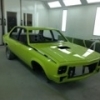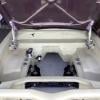Prepping panels to bare metal for body work
#1

Posted 14 September 2014 - 06:46 PM
#2

Posted 14 September 2014 - 06:54 PM
#3

Posted 14 September 2014 - 07:00 PM
Paint stripper is shit and messy,Bomber will know but probably the best way is use a stripping pad on a big variable speed grinder,it still gets hot if you stay in one spot too long,so move around ,for the creased edges,hit it with media,80grit sounds nice.
Edited by EunUCh, 14 September 2014 - 07:01 PM.
#4

Posted 14 September 2014 - 07:06 PM
#5

Posted 14 September 2014 - 07:19 PM
doing a great job so far evl666.as above 80 grit will give the etch or epoxy plenty of hold,i taped up all my seams where i didnt want
the stripper to go.but seems you are sandblasting you should be able to get at it
cheers Maz
#6

Posted 14 September 2014 - 07:24 PM
#7
 _LH SLR 3300_
_LH SLR 3300_
Posted 14 September 2014 - 07:54 PM
I don't like using coarse sanding discs/paper when stripping paint, they take the factory zinc anneal coating off. Unless you apply an etch primer straight away, the panels will begin to surface rust very quickly, especially in humid atmosphere. When I have the panels at the stage shown in your pics, I apply a medium coat of paint stripper over the panel & wearing latex gloves, I use coarse steel wool & hot water to remove the last of the original paint. I clean up with dry rags & compressed air. Water neutralises the paint stripper as well, which is important otherwise the residue can cause problems with the painting later on. Another point to remember is that Prepsol & paint thinners don't neutralise the stripper. If the panels are going to sit in bare steel for a short time before body repairs/etch priming, I apply a light coat of WD40 to prevent any surface rust. Although it is a silicon based product, it cleans off very easily with Prepsol when you are ready to begin repairs. Just my opinion based on experience in the trade & restoring my own cars.
#8

Posted 14 September 2014 - 08:07 PM
I use acrylic thinners to get the last of the paint off after paint stripper .
#9
 _mikecatts_
_mikecatts_
Posted 14 September 2014 - 08:17 PM
KBS paint stripper is your problem... It sucks big time
I use the "Body Worx" brand.. works a treat
Then if sitting I use the KBS metal ready..It coats and will keep the rust away for a little bit..
My 10 cents worth.
Mike
#10

Posted 14 September 2014 - 08:29 PM
#11
 _macdou_
_macdou_
Posted 14 September 2014 - 08:43 PM
Sand / soda / bead blasting
Paint stripper and elbow grease
Stripper disc
#12

Posted 14 September 2014 - 09:01 PM
I don't like using coarse sanding discs/paper when stripping paint, they take the factory zinc anneal coating off. Unless you apply an etch primer straight away, the panels will begin to surface rust very quickly, especially in humid atmosphere. When I have the panels at the stage shown in your pics, I apply a medium coat of paint stripper over the panel & wearing latex gloves, I use coarse steel wool & hot water to remove the last of the original paint. I clean up with dry rags & compressed air. Water neutralises the paint stripper as well, which is important otherwise the residue can cause problems with the painting later on. Another point to remember is that Prepsol & paint thinners don't neutralise the stripper. If the panels are going to sit in bare steel for a short time before body repairs/etch priming, I apply a light coat of WD40 to prevent any surface rust. Although it is a silicon based product, it cleans off very easily with Prepsol when you are ready to begin repairs. Just my opinion based on experience in the trade & restoring my own cars.
What zinc anneal coating on the body panels??? Maybe on cars built since the early '80s but not our beloved Torana's. They were made from plain old black steel sheet metal.
#13

Posted 14 September 2014 - 09:04 PM
strip the remainder off with a stripper disc, hit the bare metal with straight septone rust converter,it will go a shity grey/black color but it will rub off ready for etch primer and clean up ,keep finger grease/acid and moisture away...there was another thread about this around here about how long panels will last in this stuff.
it seems to work...just 2 bobs worth ....they usually had a lead base primer...oohhhh the good ol days.
Edited by EunUCh, 14 September 2014 - 09:05 PM.
#14
 _LH SLR 3300_
_LH SLR 3300_
Posted 14 September 2014 - 09:11 PM
I was only trying to offer help/advice based on my experience in the automotive restoration business. I guess several award winning restorations don't qualify my opinion enough. Fair enough, I'll keep my opinions to myself.
#15

Posted 14 September 2014 - 09:17 PM
I was only trying to offer help/advice based on my experience in the automotive restoration business. I guess several award winning restorations don't qualify my opinion enough. Fair enough, I'll keep my opinions to myself.
If you got any common sense listen to this guy he knows his shit
#16
 _LH SLR 3300_
_LH SLR 3300_
Posted 14 September 2014 - 09:34 PM
Have you ever noticed how some cars tend to suffer from rust more than others? Compare the amount of HQ-WB Holdens still around as opposed to XA-XC Ford. Same rings true today. Commodore panels, along with most every modern car these days, are gal coated steel. I know from experience that you have to sand this coating off before welding or using electric dent pullers. Ford Falcon don't have gal coating, for example every AU Falcon sedan I see has rust blisters along the lower edge of the boot lid, I've never seen a VR-VS Commodore suffer this. It isn't unusual for me to repair Falcons less than two years old that already have rust forming, I've even come across brand new panels from Ford with surface rust appearing under the E-coat primer. I'm no expert, but I did my apprenticeship at a long established Holden dealership working under tradesmen who worked on Toranas when they were new & gained a lot of knowledge from them & other long time GMH factory trained technicians.
#17

Posted 14 September 2014 - 09:37 PM
I was only trying to offer help/advice based on my experience in the automotive restoration business. I guess several award winning restorations don't qualify my opinion enough. Fair enough, I'll keep my opinions to myself.
Not meaning to knock your work or expertise mate. Just stating a fact about the sheet metal used in the manufacture of our old Holdens.
#18
 _LH SLR 3300_
_LH SLR 3300_
Posted 14 September 2014 - 10:25 PM
Fair enough. I have a simple test, chemically strip a Torana panel the way I have suggested. sand half the panel with P80 & leave the other half in it's raw form. Wipe a damp rag over the entire panel to leave some moisture present. I am fairly confident the area that has been sanded with P80 will show surface corrosion quicker & more heavily than the un sanded area. I have chemically stripped Torana panels in the middle of winter & left them for days with no evidence of surface rust appearing, on the other hand, I've sanded the same panels & applied a medium coat of 1K etch only to find surface rust appearing within a few days. Again, I am only trying to give the OP the benefit of my experience in the trade. I am very passionate about these cars & I've seen first hand the results of poorly executed repairs/restorations, usually when I am given the job of rectifying them.
#19

Posted 14 September 2014 - 10:42 PM
wish i could drag you over here to work on my cars lol
#20

Posted 15 September 2014 - 05:38 AM
#21

Posted 15 September 2014 - 09:02 AM
3m paint & rust stripper disks. I use 7inch variety on a slow speed pulls paint off quickly without damage to metal.Slow and let the disk work without clogging the pores is the secret.From memory 20 bucks for one which used correctly lasts very well.
#22
 _mikecatts_
_mikecatts_
Posted 15 September 2014 - 09:48 AM
Fair enough. I have a simple test, chemically strip a Torana panel the way I have suggested. sand half the panel with P80 & leave the other half in it's raw form. Wipe a damp rag over the entire panel to leave some moisture present. I am fairly confident the area that has been sanded with P80 will show surface corrosion quicker & more heavily than the un sanded area. I have chemically stripped Torana panels in the middle of winter & left them for days with no evidence of surface rust appearing, on the other hand, I've sanded the same panels & applied a medium coat of 1K etch only to find surface rust appearing within a few days. Again, I am only trying to give the OP the benefit of my experience in the trade. I am very passionate about these cars & I've seen first hand the results of poorly executed repairs/restorations, usually when I am given the job of rectifying them.
I don't like using coarse sanding discs/paper when stripping paint, they take the factory zinc anneal coating off. Unless you apply an etch primer straight away, the panels will begin to surface rust very quickly, especially in humid atmosphere. When I have the panels at the stage shown in your pics, I apply a medium coat of paint stripper over the panel & wearing latex gloves, I use coarse steel wool & hot water to remove the last of the original paint. I clean up with dry rags & compressed air. Water neutralises the paint stripper as well, which is important otherwise the residue can cause problems with the painting later on. Another point to remember is that Prepsol & paint thinners don't neutralise the stripper. If the panels are going to sit in bare steel for a short time before body repairs/etch priming, I apply a light coat of WD40 to prevent any surface rust. Although it is a silicon based product, it cleans off very easily with Prepsol when you are ready to begin repairs. Just my opinion based on experience in the trade & restoring my own cars.
I too believe that the old holdens,, I mean Ive only done LC and LJ's..
Have some form of coating on the "original" metal.... Pulled enough apart/fixed. to see that the metal does rust if you "sand" the metal..
My 5/70 LC GTR has been in "bare" metal for 2 months now, no coatings and has "no" rust on it. Its under cover in the shed with sheets on it.
The one Im doing now has had the sanding treatment at one stage in its life and the bare metal bits rust before your eyes...
So Im with you Matt... They do have a coating on them.. Maybee zinc anneal metal or chemically dipped....
Thats why I DONT tend to sand the metal.. I use paint stripper and the red scouring pad to get the paint off..
The red oxide is very tough stuff and paint stripper has a bugger of a time removing..
Dont really like to use steel wool as it tends to scratch the "coating" off...
My experiance and seeing is believing..
and welding old panels that are bare metal.. There is some slight "blow back" that I only get when welding "Zinc" coated metal.
#23

Posted 15 September 2014 - 12:09 PM
#24

Posted 15 September 2014 - 12:26 PM
#25

Posted 15 September 2014 - 01:59 PM
i always thought using 80 wet will give the epoxy more hold power.but i dont use a power tool to do it .all by hand,and all
ways in a left right direction.never had the sander and broke as all buggery lol.i know alot of peeps who use 400 wetndry
then epoxy,then 400 again.would the 400 be equivalent to the scouring pad ?.i like to start rough and gradually use
finer paper as i go through the coats to give each coat a hold over the other.i thought that made sense.
does anyone know what holden did when preparing panel.they look like they were never sanded after stripping
did they rely on the red oxide to bite into the metal ?
Edited by madtoranajzedded, 15 September 2014 - 02:11 PM.
1 user(s) are reading this topic
0 members, 1 guests, 0 anonymous users


















